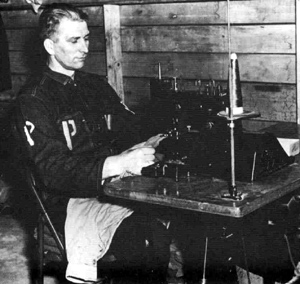
POW Camps in World War Ii
During the Second World War, Tennessee was home to eleven prisoner-of-war camps. Four were large installations. Camp Crossville was built on the site of an abandoned 1930s Civilian Conservation Corps work camp. Camp Forrest and Camp Campbell were existing army installations with extra space wherein prisoners were quartered. The Memphis Armed Service Forces Depot also housed prisoners, initially serving as a branch of a camp in Como, Mississippi.
Though nicknamed the “Jap Camp” by local residents, the Crossville camp actually contained only Italian and German prisoners. The first prisoners sent there included roughly 1,500 Germans, most of whom were veterans of General Erwin Rommel’s Afrika Korps. Camp Forrest housed nearly twice as many Germans. Camp Campbell was a special-purpose camp which served as a safe haven for dedicated “anti-Nazis.” Ironically, discipline at this camp was often a problem as these German democrats quarreled incessantly among themselves. The Memphis installation housed German and Italian prisoners.
Given benevolent treatment, which was commonplace in American camps, the prisoners generally were cooperative. Italian captives in particular proved congenial. Prisoners were at times for small wages required or requested to perform labor, mostly of an agricultural variety. Commonly, they completed their tasks adequately and without incident. Those who refused to work or performed poorly were punished with reduced rations, sometimes cut to bread and water. When the cotton compresses and warehouses in Memphis suffered from a labor shortage in the fall of 1944, prisoners from the Memphis camp worked there, and some were sent to Arkansas to pick cotton.
Security at the camps was rather lax. Prisoners were allowed, for example, to go for walks outside the compounds. Most always returned. Of 356,560 prisoners in the United States, only 1,583 “escaped,” and of those only twenty-two were never recaptured.
While escape attempts were rare, they were often interesting. The first two escapees recorded jumped from a train bound for Camp Forrest in November 1942. They were apprehended a few days later. An Afrika Korps veteran walked out of Camp Forrest to nearby Tullahoma, caught the 9:25 train to Nashville, and actually went pub-crawling with an unsuspecting GI on leave before being apprehended the next day during a routine check. One escapee from Camp Crossville who spoke English fluently remained at large for several months before returning. Not every escape attempt had a happy ending, if the following story is believed. Three German submariners who escaped from Crossville came upon a mountain cabin. Out came “granny,” who told them to “git.” When they did not leave, she shot one of them dead. When a local deputy arrived and told her of the circumstances, the woman sobbed, claiming she would never have fired had she known they were Germans. “I thought they wuz Yankees,” she said.
Conditions were comfortable for “prison.” By the Geneva Convention, the enemy never did without. Entertainments were commonplace. For example, at Camp Campbell the inmates purchased musical instruments from canteen profits and formed two complete orchestras. Germans prisoners at Memphis also formed an orchestra. Camp authorities allowed the inmates to publish newspapers at both Crossville and Camp Campbell. Barring disciplinary problems, the prisoners were even allowed to buy beer and wine!
Educational programs were established at nearly every camp. English instruction was the most common course of study. Standard coursework in chemistry, mathematics and the like was also offered, along with such local specialties as piano lessons at Crossville and a course on “The Symbolism of the American Funnies” at Camp Campbell.
There is little doubt that the prisoners appreciated the kind treatment that they received. They expressed this in letters and during postwar visits. Several even emigrated to the areas in which they had been imprisoned. In 1984 a group of German prisoners visited Memphis and the site of their old camp.
Suggested Reading
Hazel Wages, “The Memphis Armed Service Forces Depot Prisoner of War Camp: 1944-1946,” Tennessee Historical Quarterly 52 (1993): 19-32



